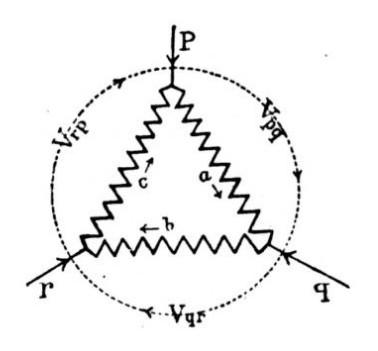Image Credit – Pravin Mishra, Milky Way Galaxy As Seen From Amphulaptsa Base Camp, CC BY-SA 4.0
Points of Discussion
- Introduction to Star & Delta Connection
- Star Connection
- Delta Connection
- Difference Between Star and Delta Connections
- Conversion from star to delta and delta to star
Star delta connection | Star delta transformation
Introduction to Star Connection and Delta Connection
Star and delta connections are the two very well-known methods for establishing a three-phase system. They are an essential and widely used system. This article will discuss the basics of both star and delta connections and relations between phase and link voltage and current within the system. We will also find out the significant differences between star and delta connection.
Star Connection
Star connection is the method where the similar types of terminals (all three windings) are connected to a single point, known as star point or neutral point. There are also line conductors, which are the free three terminals. The designing of wires at the external circuits makes it a three phase, three wire circuit and makes the star connection. There may be another wire named a neutral wire that makes the system a three phase, four-wire system.

What is meant by Thevenin’s theorem? Click Here!
The relation between Phase Voltage and Link Voltage of Star Connection

The system is considered as a balanced system. For a balanced-systems, an equal amount of current will pass through all 3-phase. That is why, R, Y, B has the same value of current. Now it has consequences. This uniform distribution of current makes the magnitudes of the voltages – ENR, ENY, ENB same and they get displaced by 120 degrees from one another.
In the above images, the arrow represents the direction of currents and voltages (not the actual order though). As we have discussed earlier, due to the uniform current distribution, the three arms’ voltage is equal so that we can write –
ENR = ENY = ENB = Eph.
And we can observe that the voltages in-between two lines is a two-phase voltage.
So, observing the NRYN loop, we can write that,
ENR` + ERY` – ENY` = 0
Or, ERY` = ENY` – ENR`
Now, from vector algebra,
ERY = √ (ENY2 + ENR2 + 2 * ENY * ENR Cos60o)
Or, EL = √ (Eph2 + Eph2 + 2 * Eph * Eph x 0.5)
Or, EL = √ (3Eph2)
Or, El = √3 Eph
In the same way, we can write, EYB = ENB – ENY.
OR, EL = √3 Eph
And,
EBR = ENR – ENB
Or, El = √3 Eph
So, we can say that the relation between the line voltage and phase voltage is:
Line Voltage = √3 x Phase voltage
What is Millman’s Theorem? Click Here!
Relation Between Phase Current and Line Current in Star Connection
The uniform current flow in phase windings is the similar as the current flow in the line conductor.
We can write –
IR = INR
IY = INY
And IB = INB
Now, the phase current will be –
INR = INY = INB = Iph
And the line current will be – IR = IY = IB = IL
So, we can say that, IR = IY = IB = IL
What is Maximum Power Transfer Theorem? Click Here!
Delta connection
Delta connection is another method to establish three phases of an electrical system. The end terminal of the windings is attached to the starting of the other terminals. Three-line conductors are connected from three junctions. The delta connection is set up by tying the ends. For that we combine a2 with b1, b2 with c1 and c2 with a1. Line conductors are the R, Y, B which run from three junctions. The below image depicts a typical delta connection and shows the end-to-end connections.

The relation between phase voltage and the line voltage of the Delta connection
Let us find out the relation between phase voltage of a delta circuit with the circuit’s line voltage. For that, observe the above image carefully. We can say that the value of the voltage at both the terminal 1 and terminal 2 is the same as the terminal R and terminal Y.
So, we can write – E12 = ERY.
In the same way, we can conclude by observing the circuit, E23 = EYE.
And E31 = EBR
The phase voltages are written as: E12 = E23 = E31 = Eph
The line voltages are written as: ERY = EYB = EBR = EL.
So, we can conclude that, in case of a delta connection, the phase voltage will be equal to the circuit’s line voltage.
To know About Kirchhoff’s Laws: Click Here!
The relation between phase current and line current in delta connection
For a balanced delta connection, the constant voltage value affects the current values. The current values of I12, I23, I31 are equal, but they are displaced by 120 degrees from one another. Observe the below-given phasor diagram.

We can write, I12 = I23 = I31 = Iph
Now, by applying Kirchhoff’s law at junction 1,
We know that the algebraic sum of the current of a node is zero.
So, I31` = IR` + I12`
The vectoral differences come as IR` = I31` – I12`
By applying vector algebra,
IR = √ (I312 + I122 + 2 * I31 * I12 * Cos 60o)
Or, IR = √ (Iph2 + Iph2 + 2 * Iph * Iph x 0.5)
As, we have discussed earlier, IR = IL.
Or, IL = √ (3Iph2)
Or, IL = √3 * Iph
In the same way, IY` = I12` – I23.`
Or, IL = √ 3 * Iph
And, IB` = I23` – I31`
Or, IL = √ 3 Iph
So, the relation between line current and phase current can be written as:
Line Current = √3 x Phase Current
Difference between Star and Delta Connection
Star and delta methods are two renowned methods for three phase systems. Depending on various factors, there are some fundamental differences between them. Let us discuss some of them.
| POINTS OF COMPARISION | STAR CONNECTION | DELTA CONNECTION |
| Definition | The three terminals are allied at a common point. This type of circuit is called a Star connection. | Three end terminals of the circuits are connected with each other to form a closed loop known as delta connection. |
| Neutral Point | There is a neutral point in star connection. | No such neutral point exists in delta connection. |
| The relation between phase and line voltage | Line voltage is calculated as √three times of phase voltage for star connection. | Phase voltage and line voltages are equal to each other for delta connections. |
| The relation between phase current and line current | Phase current and line current for star connection is equal to each other. | Line current is √three times of phase current for delta connections. |
| Speed as starters | Star connected motors are usually slower as they get 1/√3 rd of the voltage. | Delta connected motors are usually faster as they get the full line voltage. |
| Phase Voltage | The value of phase voltage for a star connection is lower as they get just 1/√3 part of the line voltage. | The value of phase voltage is higher as phase voltage, and line voltages are equal. |
| Requirement of Insulation | Low level of insulation required for a star connection. | High level of insulation is required for delta connection. |
| Usage | Power transmission networks use a star connection. | Power distribution system uses a delta connection. |
| The number of turns required. | Star connection requires a lesser number of turns. | Delta connection requires a higher number of turns. |
| Received voltage | Every single winding receives 230 volts of voltage in star connection. | In delta connection, every single winding receives 414 volts of voltage. |
| Available systems | Star connection of three wire three phases and four wire three phase systems are available. | Delta connection of three wire three phase systems, and four-wire three phase systems are available. |
Learn About Basics of AC Circuit: Click Here!
Star delta transformation
Conversion from Star to Delta and Delta to Star
A star network can be converted into a delta network, and a delta connected network can be converted into a star network if needed. Conversion of circuits is necessary to simplify the complicated course, and thus the calculation becomes more effortless.
Conversion from Star to Delta
In this conversion, a connected star network is replaced by its equivalent delta connected network. The star and replaced delta figure are given. Observe the equations.
The value of Z1, Z2, Z3 is given in terms of ZA, ZB, ZC.
Z1 = (ZA ZB + ZB ZC + ZC ZA) / ZC = Σ (ZA ZB) / ZC
Z2 = (ZA ZB + ZB ZC + ZC ZA) / ZB = Σ (ZA ZB) / ZB
Z3 = (ZA ZB + ZB ZC + ZC ZA) / ZA = Σ (ZA ZB) / ZA
We can easily convert a connected star network into a delta connected if we know the star-connected network’s value.
Learn About Advanced AC Circuit: Click Here!
Conversion from Delta to star
In this conversion, a delta connected network is replaced by its equivalent star connected network. The delta and replaced star figure are given. Observe the equations.
The value of ZA, ZB, ZC is given in terms of Z1, Z2, Z3.
ZA = (Z1 Z2) / (Z1 + Z2 + Z3)
ZB = (Z2 Z3) / (Z1 + Z2 + Z3)
ZC = (Z1 Z3) / (Z1 + Z2 + Z3)
We can easily convert a delta connected network into a star connected if we know the value of the delta connected network.
Cover GIF by: GIPHY

Hi, I am Sudipta Roy. I have done B. Tech in Electronics. I am an electronics enthusiast and am currently devoted to the field of Electronics and Communications. I have a keen interest in exploring modern technologies such as AI & Machine Learning. My writings are devoted to providing accurate and updated data to all learners. Helping someone in gaining knowledge gives me immense pleasure.
Let’s connect through LinkedIn –